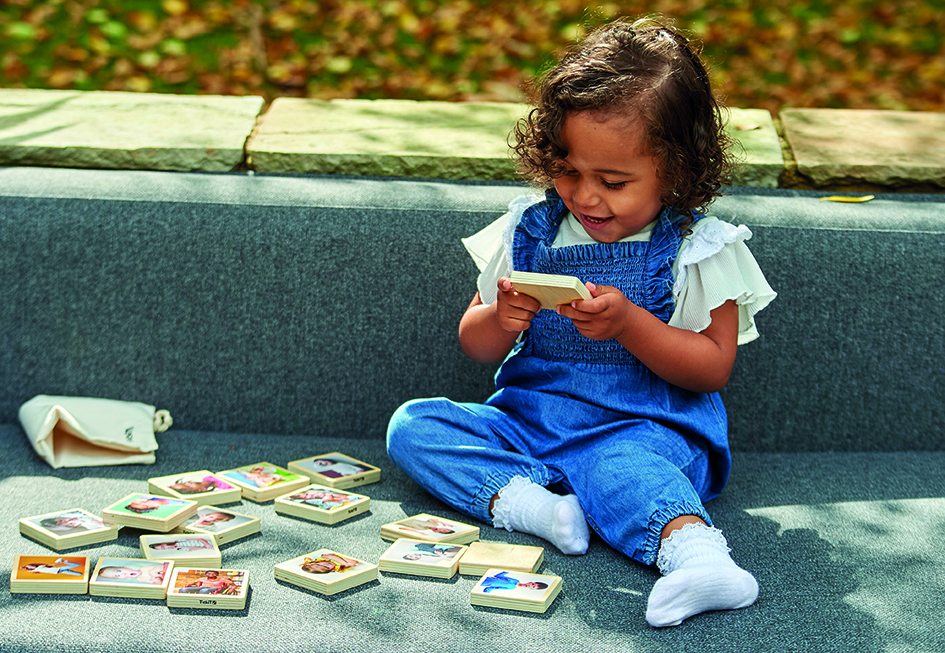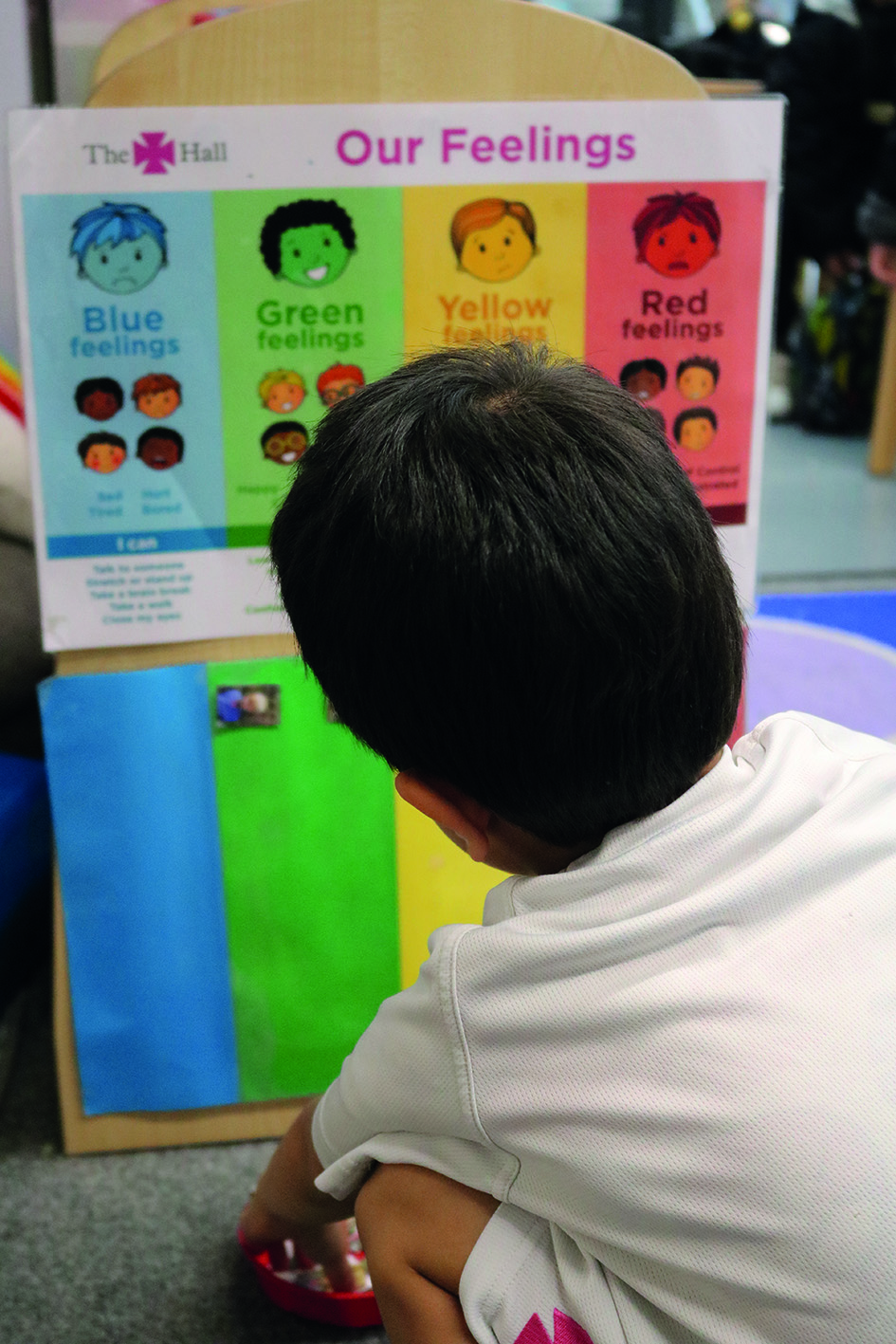
Early positive relationships play a fundamental role in children's social and emotional development. Children with secure attachments are more likely to feel safe, relaxed and loved. They are more inclined to try new things, challenge themselves and express their ideas and feelings.
‘The growth of strong neural pathways through emotional connection builds strong, healthy brains that are – eventually – capable of executive functions, such as self-regulation, and crucial for healthy functioning with others, our environment and ourselves,’ says Anne O’Connor, independent early years consultant, trainer and author, specialising in the prime areas of development.
Practitioners can help young children learn to recognise their feelings by naming and talking about different emotions using stories, drawing, crafts, role play and visual supports. By modelling calming strategies, practitioners can help build children's awareness of how to reduce or manage extremes of emotion. The environment can work for or against this, providing a secure base or be destabilising for children.
Andy Burt, curriculum consultant for Early Excellence, says, ‘Confidence and security are often built around familiarity. Building a learning environment around what we know will fascinate young children is a crucial first step to recognising and valuing their interests. Open-ended materials that can be used for an endless variety of purposes will enable children to express their interests and ideas, whatever they may be. Wooden blocks, workshop materials and sand and water resources empower children to make choices.’
Cosy spaces that children can crawl into when they are overwhelmed or sit to read a book are a great place to support children's emotional development. ‘Add soft cushions, sensory bottles or a weighted blanket to create a space children can access independently when needed,’ advises Cosy's head of products, Agata Marciniak.
SELF-REGULATION
In the aftermath of Covid, many two- to four-year-olds have missed out on social opportunities and are finding it more difficult to control their emotional and physical reactions. They may have difficulties coping with change, persevering in challenging tasks or taking physical or emotional risks. O’Connor says it is important to remember that the root of most behaviours ‘lies in fear and feelings of being unsafe’.
‘Misbehaving at tidy-up time can be a signal that a child feels anxious or fearful of change or “endings”. This is why transitions can be difficult,’ she says. ‘Think about how the day is organised so that routines support security, but also how you are physically and emotionally available to children to help them build resilience when changes inevitably occur.’
Jayne Ross, early years educator at Roberttown Community Preschool in West Yorkshire, uses an evidence-informed teaching approach to help young children manage their emotions. The technique, shown through video footage on the Education Endowment Foundation's Early Years Evidence Store (see Further information), involves resolving conflict when children fall out over who has the most playdough. In ‘It's my playdough!’, Ross connects with the group, uses key vocabulary to name the emotions and explains what is happening. She then involves other children and comes up with suggestions on how the problem can be resolved, scaffolding ideas for sharing, taking turns and meeting a compromise.
CULTURE OF DISCUSSION
Creating a culture of discussing ideas and emotions can help children make connections and build relationships. In the role-play area, when sensitively playing alongside children, ask questions to prompt discussion around feelings – ‘The baby is crying. I wonder what's wrong?’ Outside, when children are climbing on trees or jumping off crates, encourage their efforts, using phrases like, ‘Do you remember when you tried to climb up last week? This time you’ve reached the top. Well done. How do you feel? Perhaps you can help Sarah who is almost there.’
Stories that are rich in emotive language – positive and negative – are great prompts for discussions. When reading together, point to the pictures and ask, ‘Why do you think she looks upset?’ and ‘What's making him scared?’
Emotion picture cards are useful for the start of the day to find out how children are feeling. Practitioners can also use them to help resolve conflicts, inviting children to express and name their related emotions. Helping children talk about their anger or actions – for example, they wanted the toy so badly that they snatched it – is alsoa lead into communicating limits and boundaries.
RESOURCES TO SUPPORT EMOTIONAL DEVELOPMENT

 Education suppliers share with Nursery World resources that early years settings can use to support children's emotional development:
Education suppliers share with Nursery World resources that early years settings can use to support children's emotional development:
- Cosy's Montessori Emotions Box, £39.99, can be added to the self-registration station or left out at special times of the day to keep the dialogue around feelings going. Chalking Emotions, £23.99, help children express their feelings in an open-ended way by drawing features on either side and matching them up with different feelings. The Large Indoor Cosy Reading Pod, £355, is great for quiet conversations, reading – or even a nap.
- Early Excellence's Full Box of Feelings, £165, developed by Professor Ferre Laevers, includes practical activities to help children explore happiness, anger, fear and sadness in an accessible way. Try the Water Resource Collection 3-4 yrs, £175; Set of Colour Books to encourage expressive art and design activities, £34.95; the Complete Paint Easel Area 3-4yrs, £395; or the Complete Domestic Role Play Area 4-5yrs, £2,045.
- Yellow Door's Emotion Stones, £22, are great for exploring emotions outdoors and in messy, creative play. Children love exploring with playdough, and the Let's Roll – Emotions, £15, rollers can help them understand how feelings may affect the whole body, in a physical and creative way. Kindness Hearts, £20, are a great visual way to recognise acts of kindness. The Dealing with Feelings Kit, £155, encouragesa tactile and visual approach, and the Self-Regulation Stones, £20, and Sensory Worry Stones, £22, are great for transitions. Beat Babies, from £10, are great for turn-taking and also nurture emotional literacy.
- Early Years Resources’ How I Feel Today Mirror, £8.39, can be used to discuss feelings and to encourage a positive self image. Try its gender-neutral How Do You Feel Friends – Emotion Dolls – 4pk, £82.79, or the Feeling and Emotions Memory Game, £25.91.
- TickIt's My Emotions Wooden Tiles, £19.99, are a great way to introduce descriptive language around feelings. The Understanding Feelings Set, £32.99, includes different facial expressions on clear plastic faces that can be used with TickIt's light panels or against a window. Children can express themselves with the Rainbow Habutae Fabric Pack, £31.99, or Rainbow Organza Fabric, £26.99.
CASE STUDY: The Hall, an independent school for boys in Belsize Park, London
 Children's personal, social and emotional development is at the heart of the curriculum at boys’ private school The Hall School. Reception teachers use Leah Kuyper's The Zones of Regulationprogramme (see Further information) to help children understand their emotions.
Children's personal, social and emotional development is at the heart of the curriculum at boys’ private school The Hall School. Reception teachers use Leah Kuyper's The Zones of Regulationprogramme (see Further information) to help children understand their emotions.
Early years lead Dominique Shirbini says, ‘Each class has a My Feelings chart which encourages children to identify, manage and regulate their emotions throughout the day. Children are encouraged to move their individual thumbnail photos to the zones on the chart they feel they are in [see image overleaf]. We then teach the children strategies to manage their emotions.
‘We also use visual timetables, which helps them prepare for what's coming next and begin to manage their own needs. In turn, we find this helps with self-regulation, particularly those who struggle with anxiety. If a child is hungry, for example, they can look at the timetable to see how long they have to wait until lunch.
‘Our Calm Corners contain bean bags, cushions and soft toys. Children can access them at any point of the day – if they’re unwell or overwhelmed – and be comforted by a book. Core texts with a PSED focus are at the heart of our early years curriculum; we use Ruby's Worry by Tom Percival, Naughty Bus by Jan and Jerry Okie, and Jabari Triesby Gaia Cornwall, which provide excellent learning opportunities for the children.’
FURTHER INFORMATION









